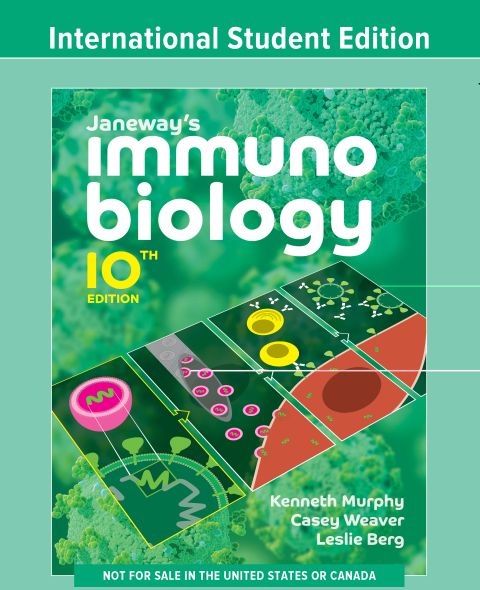Description
Efnisyfirlit
- Cover
- Title Page
- Publisher’s Notice
- Copyright
- Preface
- What’s New in the Tenth Edition
- Resources for Instructors and Students
- Acknowledgments
- About the Authors
- Contents in Brief
- Detailed Contents
- Chapter 1: Basic Concepts in Immunology
- The origins of vertebrate immune cells.
- Principles of innate immunity.
- Principles of adaptive immunity.
- The effector mechanisms of immunity.
- References
- Chapter 2: Innate Immunity: The First Lines of Defense
- Anatomic barriers and initial chemical defenses.
- The complement system and innate immunity.
- End of Chapter Questions and References
- Chapter 3: Cellular Mechanisms of Innate Immunity
- Pathogen recognition by cells of the innate immune system.
- Consequences of innate immune activation.
- End of Chapter Questions and References
- Chapter 4: Antigen Recognition by B-cell and T-cell Receptors
- The structure of a typical antibody molecule.
- Structural variation in immunoglobulin constant regions.
- The interaction of the antibody molecule with specific antigen.
- Antigen recognition by T cells.
- End of Chapter Questions and References
- Chapter 5: The Generation of Lymphocyte Antigen Receptors
- Primary immunoglobulin gene rearrangements and expression.
- T-cell receptor gene rearrangement.
- Evolution of the adaptive immune response.
- End of Chapter Questions and References
- Chapter 6: Antigen Presentation to T Lymphocytes
- The generation of αβ T-cell receptor ligands.
- The major histocompatibility complex and its function.
- Recognition of nonpeptide ligands by unconventional T-cell subsets.
- End of Chapter Questions and References
- Chapter 7: Lymphocyte Receptor Signaling
- General principles of signal transduction and propagation.
- Antigen receptor signaling and lymphocyte activation.
- Co-stimulatory and inhibitory receptors modulate antigen receptor signaling in T and B lymphocytes.
- End of Chapter Questions and References
- Chapter 8: The Development of B and T Lymphocytes
- Development of B lymphocytes.
- Development of T lymphocytes.
- Positive and negative selection of T cells.
- End of Chapter Questions and References
- Chapter 9: T Cell–Mediated Immunity
- Development and function of secondary lymphoid organs–sites for the initiation of adaptive immune responses.
- Naive T-cell activation, clonal expansion, and differentiation into effector and memory T cells.
- General properties of effector T cells and their cytokines.
- T cell–mediated cytotoxicity.
- End of Chapter Questions and References
- Chapter 10: The Humoral Immune Response
- B-cell activation by antigen and helper T cells.
- The distributions and functions of immunoglobulin classes.
- The destruction of antibody-coated pathogens via Fc receptors.
- End of Chapter Questions and References
- Chapter 11: Integrated Dynamics of Innate and Adaptive Immunity
- Integration of innate and adaptive immunity in response to specific types of pathogens.
- Effector CD4 T cells augment the effector functions of innate immune cells.
- Immunological memory.
- End of Chapter Questions and References
- Chapter 12: The Barrier Immune System
- Organization of the mucosal immune system.
- Innate immune defenses of the intestinal immune system.
- The role of adaptive immunity in regulating the intestinal mucosal immune system at homeostasis.
- The intestinal immune response in host defense and immune-mediated disease.
- Immunity at other barrier tissues.
- End of Chapter Questions and References
- Chapter 13: Failures of Host Defense Mechanisms
- Immunodeficiency diseases.
- Evasion and subversion of immune defenses.
- Acquired immune deficiency syndrome.
- End of Chapter Questions and References
- Chapter 14: Allergic Diseases and Hypersensitivity Reactions
- IgE and IgE-mediated allergic diseases.
- Effector mechanisms in IgE-mediated allergic reactions.
- Non-IgE-mediated allergic diseases.
- End of Chapter Questions and References
- Chapter 15: Autoimmunity and Transplantation
- The making and breaking of self-tolerance.
- Autoimmune diseases and pathogenic mechanisms.
- The genetic and environmental basis of autoimmunity.
- Responses to alloantigens and transplant rejection.
- End of Chapter Questions and References
- Chapter 16: Manipulation of the Immune Response
- Fighting infectious diseases with vaccination.
- Using the immune response to attack tumors.
- Treatment of unwanted immune responses.
- End of Chapter Questions and References
- Appendix I: The Immunologist’s Toolbox
- Appendix II: CD Antigens
- Appendix III: Cytokines and Their Receptors
- Appendix IV: Chemokines and Their Receptors
- Glossary
- Credits
- Index
- Movies and Animations
- Endpaper





